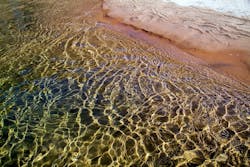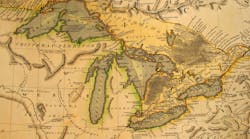The federal government declared a water shortage at Lake Mead, one of Colorado River’s main reservoirs.
The Bureau of Reclamation announced the first-ever water shortage for the lower Colorado River basin on Aug. 16.
This is in light of the bureau’s findings in the Colorado River Basin August 2021 24-Month Study. According to the bureau, due to historic drought and low runoff conditions in the Colorado River Basin, downstream releases from Glen Canyon Dam and Hoover Dam will be reduced in 2022 due to declining reservoir levels.
In the Lower Basin the reductions mark the first shortage declaration.
According to the bureau, Lake Mead, the largest reservoir in the U.S. by volume, has drained at an alarming rate in 2021, at around 1,067 feet above sea level and 35% full. Even further, the Colorado River reservoir is at its lowest since the lake was filled after the Hoover Dam was completed in the 1930s. Lake Powell, which is also fed by the Colorado River and is the country’s second-largest reservoir, also hit a record low and is now 32% full.
The bureau also included the required shortage reductions and water savings contributions under the 2007 Colorado River Interim Guidelines for Lower Basin Shortages and Coordinated Operations of Lake Powell and Lake Mead, 2019 Lower Basin Drought Contingency Plan and Minute 323 to the 1944 Water Treaty with Mexico.
“The reality is that climate change will accelerate these challenges, which will require us to think differently and innovate ways to adapt – we must build on our progress in conservation and double down on our investment in local water supplies, including recycled water and storm water,” according to Metropolitan General Manager Adel Hagekhalil in a Metropolitan Water District of Southern California press release. “We must do more.”
No Southern California counties are yet under the emergency proclamation, but residents have been asked to follow the governor’s call to reduce water consumption. California will not likely be affected immediately, but the U.S. Bureau of Reclamation has warned more cuts would be necessary.
Arizona must reduce water consumption by 18%, Nevada by 7% of the state’s annual apportionment and Mexico by 5%.
“Today’s announcement of a Level 1 Shortage Condition at Lake Mead underscores the value of the collaborative agreements we have in place with the seven basin states, Tribes, water users and Mexico in the management of water in the Colorado River Basin,” said Reclamation Deputy Commissioner Camille Touton in the bureau’s press release. “While these agreements and actions have reduced the risk, we have not eliminated the potential for continued decline of these critically important reservoirs. Reclamation is committed to working with all of our partners in the basin and with Mexico in continuing to implement these agreements and the ongoing work ahead.”
Based on the projections provided by the study, Lake Powell will operate in the Mid-Elevation Release Tier in water year 2022 (Oct. 1, 2021 to Sept. 30, 2022), and Lake Mead will operate in its first-ever Level 1 Shortage Condition in calendar year 2022 (Jan. 1, 2022 through Dec. 31, 2022).
Among the other projections are:
- The study projects Lake Powell’s Jan. 1, 2022, elevation to be 3,535.40 feet, which is approximately 165 feet below full and about 45 feet above minimum power pool. Lake Powell will operate in the Mid-Elevation Release Tier in water year 2022, releasing 7.48 million acre-feet in water year 2022 without the potential for a mid-year adjustment in April 2022.
- The study projects Lake Mead’s Jan. 1, 2022, elevation to be 1,065.85 feet, about 9 feet below the Lower Basin shortage determination trigger of 1,075 feet and about 24 feet below the drought contingency plan trigger of 1,090 feet. Lake Mead will operate in a Level 1 Shortage Condition for the first time ever.
More information about this water shortage can be found here.






